Newsletters & Notes
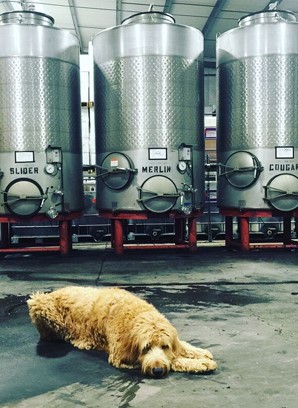
Contest Winner: Guessing the Date of our First Red Grape Harvest
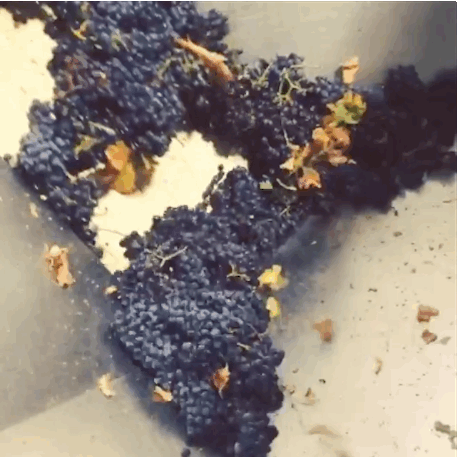
Earlier this summer we launched our first Harvest Date Contest, challenging our Tribe members and fans to guess when our first load of grapes would arrive. Our first load of red grapes arrived Sunday, September 7 at 3:37pm. Fittingly for our newest release, it was the Dry Creek fruit for our Winemakers’ Handprint Merlot!
Longtime Tribe member Tom Martenson is our winner, with a guess that was just 20 hours off the mark. Tom and his wife Kristen take their duties as Tribe members and wine junkies seriously–they brought their whole wedding party to our winery for a tour, invited Molly & Charlie to their wedding, and travel to wine country often to quench their thirst for new wines and fresh adventures in wine country.
And, thrillingly, the grapes look great. The fruit, from Cam Mauritson’s vineyard off Canyon Road, is one of the star ingredients in the Handprint Merlot, delivering depth, tannin, and flavor. We’re grateful for our partnership with Cam and so many other fine growers–and proud to release another great Winemakers’ Handprint Merlot.
Some Stories Along the Way
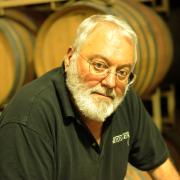 My dad loved wine. His name was Charles Rutherford Meeker Jr. I’m Charles Rutherford Meeker III. My grandfather, Charles Rutherford Meeker, Senior, was born during the presidency of Rutherford B. Hayes. My great-grandfather was named John Quincy Adams Meeker. John Q. A.’s father was Thomas Jefferson Meeker, Jr. Thomas Jr.’s father, my great-great-great grandfather, was born in New Jersey in 1805 and named in honor of our country’s President at the time. Thomas Jefferson was not only our third President, but also loved wine, planted vineyards, and established the first winery in America. I guess that pretty much explains everything about me and my love for wine.
My dad loved wine. His name was Charles Rutherford Meeker Jr. I’m Charles Rutherford Meeker III. My grandfather, Charles Rutherford Meeker, Senior, was born during the presidency of Rutherford B. Hayes. My great-grandfather was named John Quincy Adams Meeker. John Q. A.’s father was Thomas Jefferson Meeker, Jr. Thomas Jr.’s father, my great-great-great grandfather, was born in New Jersey in 1805 and named in honor of our country’s President at the time. Thomas Jefferson was not only our third President, but also loved wine, planted vineyards, and established the first winery in America. I guess that pretty much explains everything about me and my love for wine.
I was born and raised in Dallas, Texas, and although I’ve happily lived in California since 1967, I’m still proud to call myself a Texan. My mother’s family was farming in East Texas when it was still part of the Republic of Texas, so my heritage in that great state runs deep. But back the in the 1950’s, when I was a teenager, Texas wasn’t what you’d call a hot spot for wine lovers. Lone Star Beer, bourbon and branch water, scotch and soda – that was pretty much it. Except, that is, for my father. The only alcoholic beverage Dad would drink was wine. He liked white wine, red wine and Champagne, but most of all, he adored red French Burgundies.
For 16 years, from 1944 to 1960, Dad was Managing Director of the Dallas Summer Musicals, where he oversaw the production of nine Broadway-type musicals each year – eight for two-week runs over the summer, and the ninth for several weeks each October during the annual State Fair of Texas. This job took Dad regularly to New York to see shows, hire personnel and otherwise work toward making the Dallas musicals a success — which they were, and still are, currently under the excellent management of my father’s protégé, Michael Jenkins.
I never specifically asked, but I’d guess that Dad developed his love for wine during those many business trips to New York City, then and now one of the great world capitals of wine appreciation. But when the Broadway stars came to do a show for my Dad at the State Fair Music Hall, what they wanted to do most of all was visit Neiman-Marcus – a world-famous store then located only in downtown Dallas. Stanley Marcus, the store’s co-founder, was Dad’s friend, and he would often personally open the store on Sunday – this was, keep in mind, the 1950’s — just so that one or another Broadway star could shop there. Mr. Marcus was also a great wine lover, and when he founded the Dallas chapter of the Confrérie des Chevaliers du Tastevin (a society of Burgundy wine enthusiasts originally founded in 1703), my father was one of the first members. I was too young to accompany my parents to the Confrérie’s elaborate dinners, but I listened well to Dad’s reports when they returned home, and later, when I was living in Los Angeles, Stanley Marcus arranged for me to join the Confrérie’s chapter there.
My father enjoyed nothing more than sitting around with a group of friends and telling stories about his adventures in the theater business. Jack Paar (Johnny Carson’s and Jay Leno’s predecessor) had him as a guest on NBC’s The Tonight Show twice, so that he could tell some of those stories to a wider audience.
Dad didn’t live to see me move the family into the wine business in Sonoma County. If he had, he’d no doubt be amazed by the great success of California wine in the world today, and he’d be proud of what we’ve done with our family winery. Most of all, I know he’d enjoy hearing some of the stories I’ve got to tell about what happened along the way.
Don’t Be Prejudiced Against Pink: Rosé is Pretty Fabulous

In the early 1990s, when Charlie Meeker was still practicing as an entertainment lawyer, he often traveled to France where he represented the bank Credit Lyonnais. On many a warm evening in summer, Charlie enjoyed a cold, crisp glass of French Rosé on his hotel balcony. These wines were fresh, fruity, acidic – and decidedly not sweet.
He returned to the winery eager to replicate the many French Rosés he came to love, with a bit of a Californian twist. First, we call it Pink Elephant – irreverent at the core. But second, we make it in a decidedly nontraditional way. Historically, French Rosés are most typically made by crushing lighter red grapes like Grenache and Gamay and leaving them only briefly on the skins for gentle color and tannin extraction, and fermenting them dry – resulting in a ballerina pink color and fresh fruit characteristics.
As is his normal practice, Charlie decided to turn this on its head. Our Pink Elephant is a blend, made from the free run juice of our red grape harvests, some fruity red juice and usually a dash of Chardonnay for complexity. As a result, our Pink Elephant is not sweet. It’s a layered, acidic, light-bodied wine intended for summer drinking on your deck, in your garden or at a picnic.
We’ve been making Pink Elephant since the early 1990s, and for many years, it was tough to get folks in the tasting room to even taste Pink Elephant. They assumed it was like the fruit punch-tasting Blush they probably drank in college, with heavy sweetness and not a lot of wine characteristics. These Blush wines are easily conflated with Rosés, but they’re not the same thing.
So here’s the moral of the story for those of you looking for something a little lighter to drink when it’s hot out in the summertime: Don’t be prejudiced against pink. Ask the right questions and you might end up with just the right wine for you.
Contest: Guess the Date of our First Red Grape Harvest and Win!
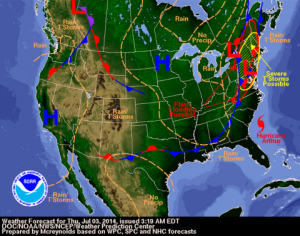
This is shaping up to be a hot, dry year in wine country – with many vineyard managers and armchair prognosticators wondering if we’ll see some of the earliest-ever harvests of grapes in Sonoma County.
After an evening at the Haun Vineyard last week (in which Charlie and Graham tried to project the date we’ll bring in their beautiful Merlot grapes), we decided to open the guessing to our Tribe members (with great prizes).
So, we welcome you to participate in our first-ever Red Grape Harvest Date Contest. Here are THE RULES:
-
Comment on this blog post with your guess (oops, I mean your scientific forecast) of the date and time we’ll harvest our first red grapes. Your entry should look something like: 9:15 am, September 14, 2014. You can show your work if you like, but make sure the date & time are up front!
-
Deadline for entries is midnight on July 10, 2014. Update: We’re extending the deadline to midnight Monday, July 14, 2014.
-
One entry per person.
-
We’ll keep you updated on this blog and social media with veraison spotting and Charlie’s Weather Reports.
-
When we get the first red grape delivery at the winery, we’ll mark the time the truck pulls into our gates as the winner.
-
The closest guess to the right date and time gets a coupon for 90% off any order up to $250. (Legally, in the state of California, we can’t give away wine.) Winner can pick up wine in the tasting room or have the wine shipped to legal destinations in the United States.
Questions? Email Kelly Meeker.
Information and Resources
Here’s a little background information to add to the fun.
-
We get grapes primarily from Sonoma County, but also from Mendocino County and Sierra Foothills (Yuba County). Update: For the purposes of this contest, we’re counting grapes for The Meeker Vineyard wines only, not Lucas J Cellars.
-
We harvest a wide range of varietals, from Zin and Syrah to Cabernet Sauvignon and Merlot.
No more tips. Let the games begin!
A Note from Charlie on Our Recent Winery Move
Dear Tribe,
We have excellent news! As you may already know by way of email from Julia, we have moved our winery facility from Santa Rosa (where we were located for the past seven years) to a building at 5 Fitch Street in Healdsburg Fitch Street runs north-south two short blocks east of Healdsburg’s famous town square, and our new facility is two blocks south on Fitch Street.
We have a long-term lease for about 11,000 square feet in the rear of the building, plus a large adjoining outdoor concrete work area. We have also built a two-story winery office complex in one corner of our space at the building. Another winery, Longboard Vineyards occupies a smaller portion of the building, and has its tasting room at the front of the building.
Moving was a big job. We had to move 11 large stainless steel fermentation tanks, plus about 1,200 barrels filled with wine, plus approximately 7,000 cases of bottled wines, plus lots of winemaking equipment, plus lots of office equipment and files. And it’s amazing how much other miscellaneous stuff you accumulate over seven years at one location.
Our winery telephone numbers remain the same, and we are also continuing our long-time practice of using Molly’s and my residence address (5377 Dry Creek Road, Healdsburg, CA 95448) as our winery mailing address. We are very pleased with our new space at 5 Fitch Street.
The owners of the building have just finished extensive remodeling, including a new, heavily insulated roof, as well as new wall insulation and paneling. We are already looking forward to processing the 2014 grape harvest there and showing off the new winery facility to our Tribe members when they are in the Healdsburg area. Come visit soon!
Best,
Charlie
From Tank to Bottle: Wine’s Journey Down the Bottling Line
In the beginning, like many small wineries, at The Meeker Vineyard we bottled our wine by hand. Wine was shepherded from the tank to the filler to the corker to the labeler by hand. While this process is quaint, it has several weaknesses – the manual process allows many variables to be introduced and makes it difficult to ensure each bottle is consistent. Also, it’s not very cost-effective.
In 2005, after many years of hiring bottling companies to bring their lines to us, we decided it was time to get real. We purchased our own, sophisticated bottling line. Encased in the back of a semi-truck trailer, this line can bottle about 38 bottles a minute – a lot more than our old manual process could accomplish!
This short video shows you the wine’s journey – the process for packaging each wine securely in a bottle.
The bottling process begins with two inputs:
- A hose and pump delivering wine
- A forklift delivering pallets of empty wine bottles
The first step on the truck is unloading each box of empty glass onto the conveyor belt. The belt brings each bottle to the sparger, which flips the bottle upside down and blows nitrogen into it to knock out dust and force out oxygen.
Next, the bottle gets flipped right-side-up and goes to the filler, which dispenses precisely 750 mls of wine into each bottle. From there, the bottle scoots down the line to the corker and foiler. We can also screw cap our wines with this truck – the corker simply rotates out of the way to make room for the screwcapper.
The final, and most finicky, step is the labeler, which slaps a label onto each bottle in precisely the right place. Our labeler can place either one label or a front and back label pair, as needed.
Since this video features our Winemaker’s Handprint Merlot, you’ll notice that these bottles look a little naked. In a few weeks, we’ll bring the bottles back out again for hand printing – another time-intensive process! Finally, the bottles are placed back into their cases and fly down the conveyor belt for stacking on a pallet.
We’re always pleased to get wines into bottle – it’s one step closer to the consumer and the cash register, of course – but it also feels like putting the wine to bed. The winemaker’s job is done, and the wine drinker takes it from here!
Tasting Notes: Ten Years of Handprint Merlot

After our recent exploration of how Handprint becomes Handprint, we are pleased to share tasting notes for our “library wines” – past vintages of Handprint Merlot you may have in your cellar.
Last spring, our friends Al & Patti Kruse graciously invited us to partake in drinking their 10-year vertical of Winemaker’s Handprint Merlot – and despite our, ahem, enjoyment of the evening we managed to take notes.
All of the Handprints are Sonoma County except where noted.
1998 (13.8% ABV)
The youngest in the bunch – we figured this one would be ready to drink, if not past its prime! But this wine might have another 5 years on it. There’s plenty of fruit, bright flavors and a full palate–our only criticism here was a slightly short finish–but perhaps that’s to be expected after 15 years.
1999 (14.2% ABV)
Mendocino County
This has a distinctly Cabernet-ish nose, with great color and a flavor profile like a French Bordeaux. We recommend drinking this now or within the next year.
2001 (14.5% ABV)
When we got to the ’01, Luke yelled (if you know him, you know what I mean), “I’m glad we decanted this one.” This is a Merlot that makes Sideways look stupid – it’s huge, with cassis in the nose and blackberry jam on the palate. This has another 5 years on it and should be decanted well in advance of consumption.
2002 (14.8% ABV)
This was Luke’s favorite of the older wines, with big, broad flavors and a lot of complexity. We commented on the oaky nose and muscular flavors. This would be another one to decant and drink in the next four or five years.
2003 (14.9% ABV)
If you’re going to drink this now, Molly recommends her trusty “mega decant” technique – put it in a blender and pulse for a minute or so. This instant aeration will help open up the flavors. This has a cassis aroma, with some hot undertones. Charlie thinks this is not quite ready to drink and would benefit from another few years of rest.
2004 (14.6% ABV)
The ’04 is another candidate for the blender decant – it has a flashy, vanilla-smoky nose and some hints of soil flavors on the palate. This is another wine that should be stashed in your 2014-2016 time capsule!
2005 (14.8% ABV)
This wine tastes like Handprint concentrate – huge intense flavors, and still tannic on the finish. This wine is probably not yet at its prime and will certainly age another 5-8 years.
2006 (14.4% ABV)
This wine exhibits our classic Handprint profile – cherry, cola and spice, with hints of smoky oak. This wine is drinking really well now and we recommend drinking within the next year or two.
2008 (Apparently by the 2008 I forgot to write down the ABVs. I’ll look this up in the cellar tomorrow.)
This is a young wine that has many years ahead of it. The tannins are big and it shows off its Cab influence. How long will it age? Call us back in 5 years and we’ll let you know!
2009
Our newest Handprint – this is still in Big Red Preschool. Cherry, cola and chai flavors mix make me dream of many big dinners for years to come. I hope Molly (“Mom” to me) will make eggplant parmesan. Mmmmmm.
Are you hoarding Handprint in your cellar? If so, let us know how it’s tasting next time you get a chance. We love to keep up with our wines in the wild.
Thanks again to the Kruses for generously opening their library to share with us. The evening was a treat we will remember for years to come.
How to Handprint: The Story of Our Winemaker’s Handprint Merlot

Many Tribe members and customers learn about us because of our Winemaker’s Handprint Merlot – a unique bottle that’s eye-catching on the shelf and of course palate-grabbing in your glass. The textured bottle leaves you wondering if these people really have time on their hands (heh) to print each bottle by hand. Of course, we do. And here’s the story of how it gets done.
Handprint is special because of the unique combination of wine and the package. Each bottle is held in paint-soaked hands one last time by either Winemaker Charlie or Winemaker Lucas Meeker before we ship it out the door.
It starts with the paint. Some have office supply cabinets full of reams of paper, pencils and ethernet cables – we have shelves upon shelves of artist-quality acrylic paint.
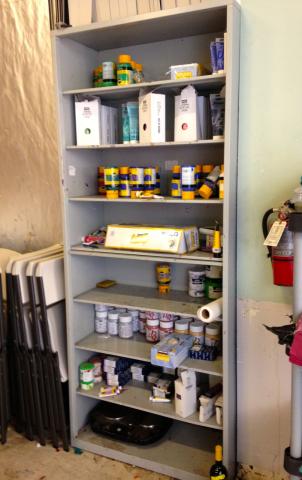
Then we get out the paint tray. Years ago, Charlie pressed his hands into plaster of paris to create these molds. Over the years they’ve accreted layers upon layers of paint and their own dingy charm. Lucas’ hands (like father like son!) work just fine in Charlie’s mold.
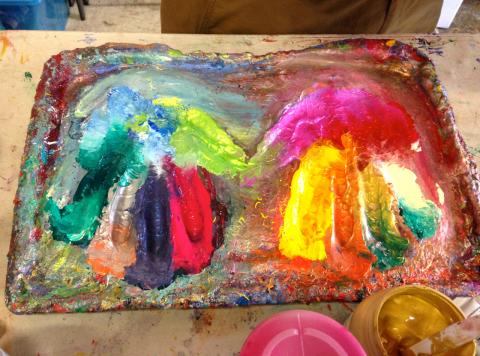
Then either Charlie or Lucas presses his hands into the molds. (Color note – you can tell these are Lucas’ hands because Charlie always uses an orange for his right thumb.)
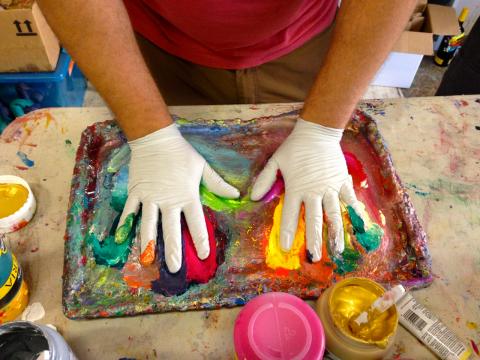
You have to be careful to make sure that the paint stays in the center of the finger so you can create a clear hand outline on the bottle.
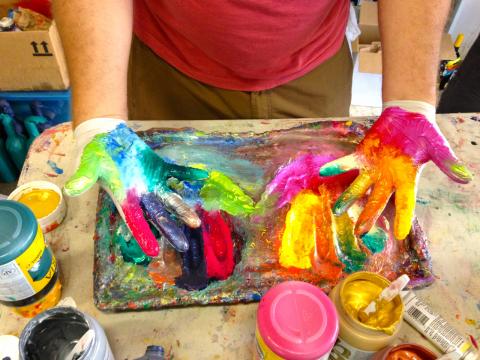
Once his hands are good and goopy, Lucas grabs the bottle, being careful to keep his fingers spread to avoid the dreaded catcher’s mitt effect. Both Charlie and Lucas are very particular about Ty, our winery Operations Manager, holding the bottles at exactly the right angle for maximum efficiency.
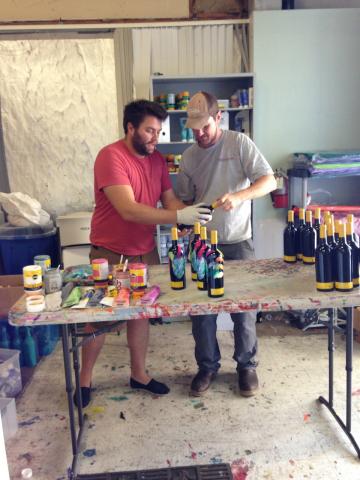
After being printed, each bottle is lined up to dry in our Handprinting Room for a couple of days, depending on the humidity and temperature. After it’s dry, each bottle gets wrapped in tissue paper and re-cased for shipment.

To us it’s Handprint – our best-selling wine – but we want to be clear that it’s more than a pretty face. Handprint is a Meeker Merlot – and that means it’s layered, full-bodied and complex. Cherry, spice, tannin and vanilla flavors come together and get better in the bottle year after year.
Our Handprints are handmade in the same way we make our wine – with attention to the details and love for both wine and the people who drink it. From our hands to yours!
Negative Ghostrider, The Pattern Is Full
For too many years, our eleven stainless steel fermentation tanks have been known by their number. Hard to remember, easy to confuse. Yesterday we decided that like our wines, our tanks deserved their own identity.
Your Ego Is Writing Checks Your Body Can’t Cash
So we got out our stencils and spray paint and named them after the pilots in the defining movie of a generation.
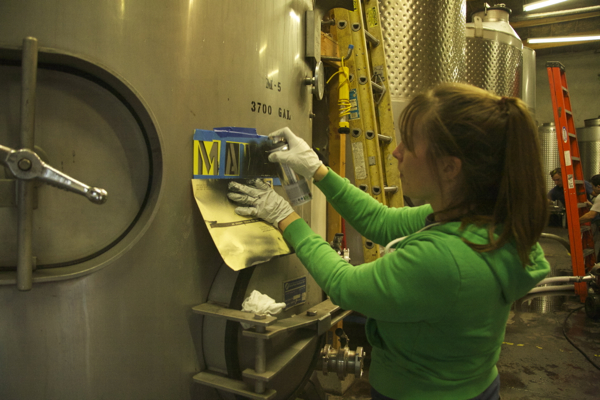
Top Gun rules of engagement exist for your safety and for that of your team. They are not flexible, nor am I.
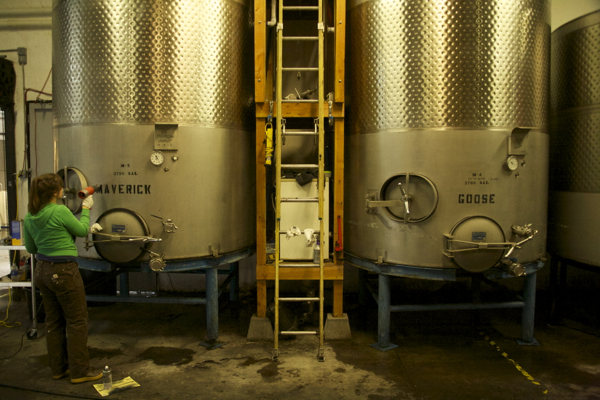
This is what I call a tank-rich environment.
When we were done we celebrated with some beach volleyball.
Now Seeking 2013 Harvest Interns!
The Meeker Vineyard is a family owned and operated winery in Santa Rosa, CA. We are dedicated to making high quality, artisanal wines. We are seeking hard-working interns with a strong attention to detail for the 2013 harvest. Interns will be involved in all aspects of winemaking and will assist with other winery tasks. Job duties include, but are not limited to:
Cleaning & sanitizing winemaking equipment and cellar
Weighing and sorting grapes before crush
Assisting with crushing and pressing
Pumpovers and punchdowns during fermentation
Collecting samples and recording data on fermenting wines
Moving juice and wine to and from tanks and barrels
Maintenance and racking of wines
Inoculating juice for fermentation
Assisting with bottling and packaging
Assisting with shipping
Previous experience working in a winery is preferred. Requirements for the position are as follows.
– Work at least 40 hours per week, August through as late as December.
– Work on a flexible schedule
– Ability to lift 50+ lbs.
– Ability to work on your feet for the majority of the day
– Communicate with other team members (both oral and written)
Other desirable skills include: Familiarity with winery equipment, ability to drive a forklift, understanding of sanitary practices.
We are not accepting calls for this position. Please email a cover letter and resume to jobs@meekerwine.com.
